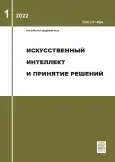No 1 (2022)
Intelligent Systems and Robots
Reflex or Reflection? Oculomotor Behavior of the Companion Robot, Creating the Impression of Communicating with an Emotional Being
Abstract
The control system of the companion robot F-2 implements a competitive system of productions (scenarios) to model the robot’s reaction in response to a wide range of events. The system is designed to provide balanced robot’s responses to speech utterances and other events recognized by the computer vision system (orientation of the user’s face and gaze, events in the Tangram game), as well as to the user’s touches. In the represented experiment, we apply this system to evaluate two robots that respond differently to the orientation of a person’s face and the direction of the gaze. According to the results, the balance of the robot’s oculomotor activity between fixation on human eyes and other current tasks is a key element ensuring a sense of social contact with an artificial agent. For the first time, it was found that the intensity of such an impression in the case of a robot implementing eye-to-eye contacts is determined by the level of the user's emotional intelligence. Implicit human reactions to the robot's gaze are also examined. In conclusion, we consider the problem of differences between reflexive and reflex behavior in eye movements in comparison with other communicative cues. We consider the question: what can be the minimum requirements to the architecture of a cognitive model capable of inducing the impression of the believability of robot behavior? In our opinion, this architecture should provide a balance between the social contacts and processing of target stimuli, responding with various communicative reactions, including reactions that are not the priority in this context. These behavioral cues of the “second priority” may give a person the impression of communicating with an emotional being.
 3-18
3-18


Mathematical Models of Dynamics of Emotional Robots' Interest in Media Projects
Abstract
The paper considers mathematical models that describe the education of emotional robots. The authors propose a mathematical model of the emotional robot's interest in media projects. The experiments results show that the mathematical model of the robot's interest is adequate to the human interest. An algorithm for constructing a schedule for broadcasting media projects is proposed, which ensures the constant interest of emotional robots in media projects.
 19-25
19-25


System, Evolutionary, Cognitive Modeling
System-Object Determinant Analysis. Construction of Genetic and Partitive Classifications of the Subject Area
Abstract
The paper considers the second and third stages of the system-object determinant analysis, including the construction of genetic and partitive classifications of the subject area. Class systems and phenomenon systems are described using a single system-object approach "Node-Function-Object" and formalization means in the language of descriptive logic ALCHOIQ (D). Partitive classification is obtained using a formal-semantic normative system based on the classification of alphabetical nodes and links. Examples of constructed genetic and partitive classifications are given.
 26-34
26-34


Analysis of Textual and Graphical Information
Identification of Linguistic Indicators of Network Socio-Political Discourse Using Text Mining
Abstract
The paper studies the socio-political discourse using methods of intellectual analysis of texts in social and political psychology. A methodology for applying tools in socio-political research is proposed. The most significant psycholinguistic indicators for comments on political and non-political Russian-language YouTube channels have been identified and analyzed.
 35-44
35-44


Analysis of Signals, Audio and Video Information
Comparison of the Methodology for Hypothesis Testing of the Independence of Two-Dimensional Random Variables Based on a Nonparametric Classifier
Abstract
The properties of a new method for hypothesis testing of the independence of random variables based on the use of a nonparametric pattern recognition algorithm corresponding to the maximum likelihood criterion are considered. The estimation of the distribution laws in classes is carried out according to the initial statistical data under the assumption of independence and dependence of the analyzed random variables. Under these conditions, estimates of the probabilities of pattern recognition errors in classes are calculated. According to their minimum value, a decision is made on the independence or dependence of random variables. The results of the proposed method are compared with the Pearson criterion and the Pearson, Spearman and Kendall correlation coefficients. When implementing the Pearson criterion, the formula for optimal discretization of the range of values of a two-dimensional random variable is used. Their effectiveness in complicating the dependence between random variables and changing the volume of initial statistical data is studied by the method of computational experiment.
 45-56
45-56


Intelligent Planning and Control
Effective Bounded-Suboptimal Algorithm of Solving Multi-Agent Pathfinding Problem
Abstract
The paper considers the problem of finding a combination of collision-free trajectories for a set of agents capable of performing actions of arbitrary duration. To solve this problem, two bounded-suboptimal modifications of the continuous-time conflict-based search algorithm are proposed. The results of the carried out model experimental studies have demonstrated the high computational efficiency of the proposed modifications.
 57-70
57-70


Computational Intelligence
Fuzzy Medians as Aggregators of Fuzzy Information
Abstract
On the basis of fuzzy medians of fuzzy number systems, a class of averaging operators is introduced and studied for the implementation of the problem of aggregation of fuzzy information. The established properties of symmetry, idempotence, continuity, monotonicity of averaging operators are a modification of the characteristic properties of scalar aggregation functions for the fuzzy case. Additionally, the properties of additivity and homogeneity, the extreme property, are established. This determines the adequacy of the use of fuzzy medians in the tasks of aggregating fuzzy information.
 71-77
71-77











